Peugeot Bipper 2008 Owners Manual
Manufacturer: PEUGEOT, Model Year: 2008, Model line: Bipper, Model: Peugeot Bipper 2008Pages: 131, PDF Size: 1.44 MB
Page 91 of 131
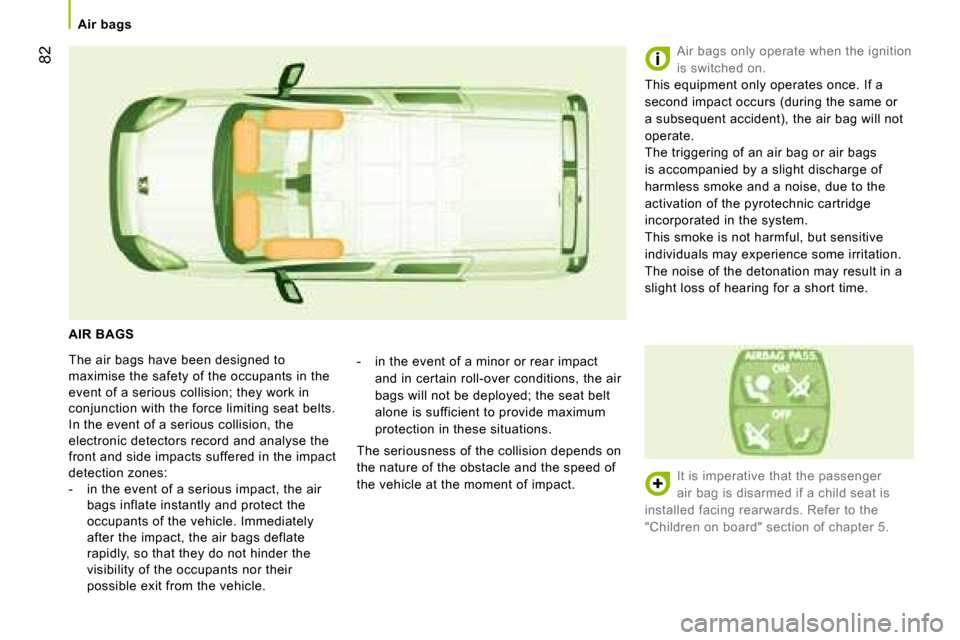
82
Air bags
AIR BAGS
The air bags have been designed to
maximise the safety of the occupants in the
event of a serious collision; they work in
conjunction with the force limiting seat belts.
In the event of a serious collision, the
electronic detectors record and analyse the
front and side impacts suffered in the impact
detection zones:
- in the event of a serious impact, the air bags inflate instantly and protect the
occupants of the vehicle. Immediately
after the impact, the air bags deflate
rapidly, so that they do not hinder the
visibility of the occupants nor their
possible exit from the vehicle. - in the event of a minor or rear impact
and in certain roll-over conditions, the air
bags will not be deployed; the seat belt
alone is sufficient to provide maximum
protection in these situations.
The seriousness of the collision depends on
the nature of the obstacle and the speed of
the vehicle at the moment of impact.
Air bags only operate when the ignition
is switched on.
This equipment only operates once. If a
second impact occurs (during the same or
a subsequent accident), the air bag will not
operate.
The triggering of an air bag or air bags
is accompanied by a slight discharge of
harmless smoke and a noise, due to the
activation of the pyrotechnic cartridge
incorporated in the system.
This smoke is not harmful, but sensitive
individuals may experience some irritation.
The noise of the detonation may result in a
slight loss of hearing for a short time.
It is imperative that the passenger
air bag is disarmed if a child seat is
installed facing rearwards. Refer to the
"Children on board" section of chapter 5.
Page 92 of 131
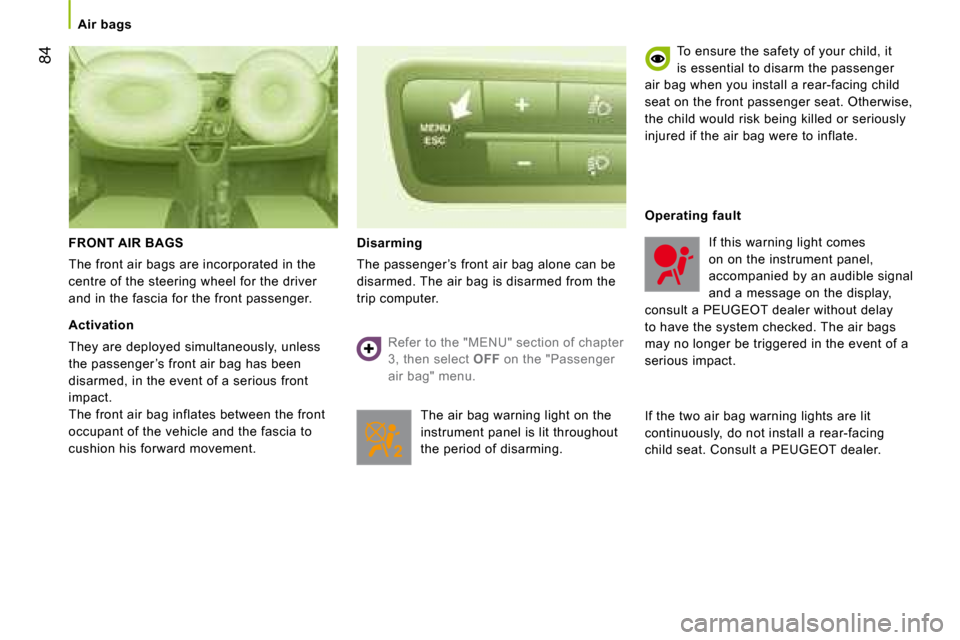
84
Air bags
FRONT AIR BAGS
The front air bags are incorporated in the
centre of the steering wheel for the driver
and in the fascia for the front passenger.
Activation
They are deployed simultaneously, unless
the passenger ’s front air bag has been
disarmed, in the event of a serious front
impact.
The front air bag inflates between the front
occupant of the vehicle and the fascia to
cushion his forward movement.
Disarming
The passenger ’s front air bag alone can be
disarmed. The air bag is disarmed from the
trip computer. The air bag warning light on the
instrument panel is lit throughout
the period of disarming. To ensure the safety of your child, it
is essential to disarm the passenger
air bag when you install a rear-facing child
seat on the front passenger seat. Otherwise,
the child would risk being killed or seriously
injured if the air bag were to inflate.
Refer to the "MENU" section of chapter
3, then select OFF on the "Passenger
air bag" menu.
Operating fault
If the two air bag warning lights are lit
continuously, do not install a rear-facing
child seat. Consult a PEUGEOT dealer . If this warning light comes
on on the instrument panel,
accompanied by an audible signal
and a message on the display,
consult a PEUGEOT dealer without delay
to have the system checked. The air bags
may no longer be triggered in the event of a
serious impact.
Page 93 of 131
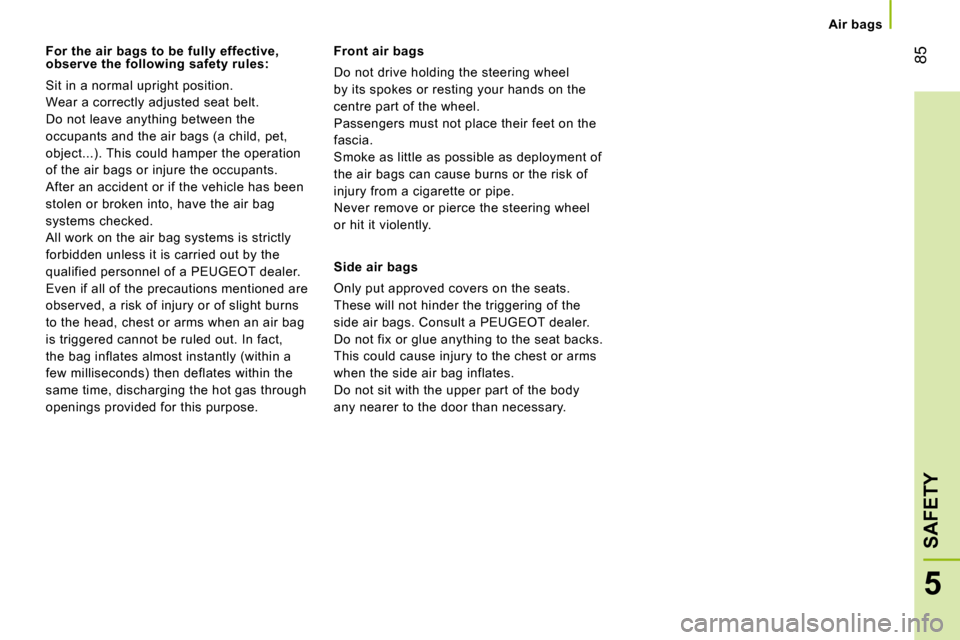
85
5
SAFETY
Air bags
For the air bags to be fully effective, observe the following safety rules:
Sit in a normal upright position.
Wear a correctly adjusted seat belt.
Do not leave anything between the
occupants and the air bags (a child, pet,
object...). This could hamper the operation
of the air bags or injure the occupants.
After an accident or if the vehicle has been
stolen or broken into, have the air bag
systems checked.
All work on the air bag systems is strictly
forbidden unless it is carried out by the
qualified personnel of a PEUGEOT dealer .
Even if all of the precautions mentioned are
observed, a risk of injury or of slight burns
to the head, chest or arms when an air bag
is triggered cannot be ruled out. In fact,
the bag inflates almost instantly (within a
few milliseconds) then deflates within the
same time, discharging the hot gas through
openings provided for this purpose.
Front air bags
Do not drive holding the steering wheel
by its spokes or resting your hands on the
centre part of the wheel.
Passengers must not place their feet on the
fascia.
Smoke as little as possible as deployment of
the air bags can cause burns or the risk of
injury from a cigarette or pipe.
Never remove or pierce the steering wheel
or hit it violently.
Side air bags
Only put approved covers on the seats.
These will not hinder the triggering of the
side air bags. Consult a PEUGEOT dealer .
Do not fix or glue anything to the seat backs.
This could cause injury to the chest or arms
when the side air bag inflates.
Do not sit with the upper part of the body
any nearer to the door than necessary.
Page 94 of 131
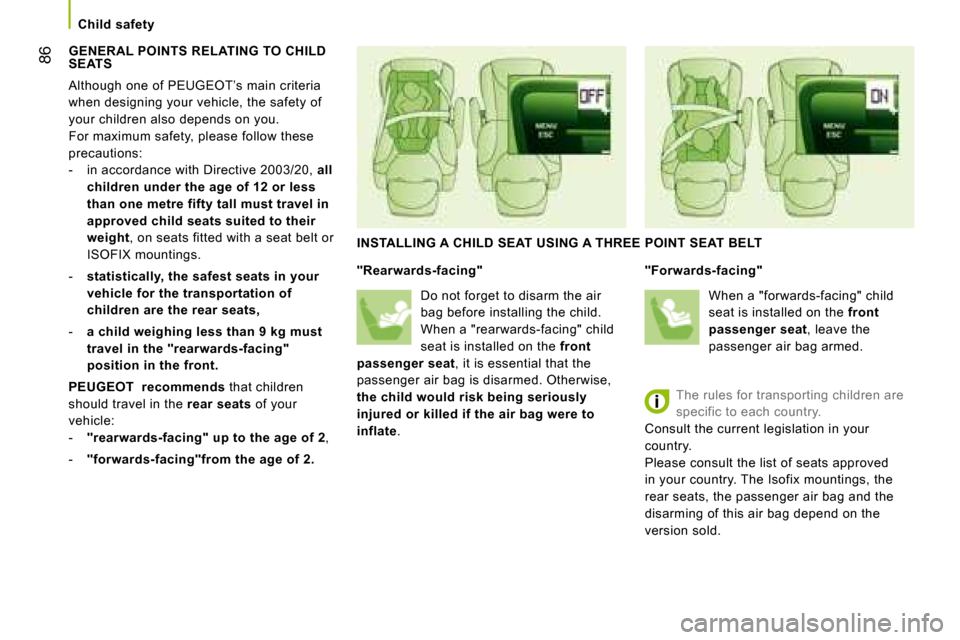
86
Child safety
GENERAL POINTS RELATING TO CHILD SEATS
Although one of PEUGEOT ’s main criteria
when designing your vehicle, the safety of
your children also depends on you.
For maximum safety, please follow these
precautions:
- in accordance with Directive 2003/20, all
children under the age of 12 or less
than one metre fifty tall must travel in
approved child seats suited to their
weight , on seats fitted with a seat belt or
ISOFIX mountings.
- statistically, the safest seats in your
vehicle for the transportation of
children are the rear seats,
- a child weighing less than 9 kg must
travel in the "rearwards-facing"
position in the front.
PEUGEOT recommends that children
should travel in the rear seats of your
vehicle:
- "rearwards-facing" up to the age of 2 ,
- "forwards-facing"from the age of 2.
INSTALLING A CHILD SEAT USING A THREE POINT SEAT BELT
"Rearwards-facing"
Do not forget to disarm the air
bag before installing the child.
When a "rearwards-facing" child
seat is installed on the front
passenger seat , it is essential that the
passenger air bag is disarmed. Otherwise,
the child would risk being seriously
injured or killed if the air bag were to
inflate .
"Forwards-facing"
When a "forwards-facing" child
seat is installed on the front
passenger seat , leave the
passenger air bag armed.
The rules for transporting children are
specific to each country.
Consult the current legislation in your
country.
Please consult the list of seats approved
in your country. The Isofix mountings, the
rear seats, the passenger air bag and the
disarming of this air bag depend on the
version sold.
Page 95 of 131
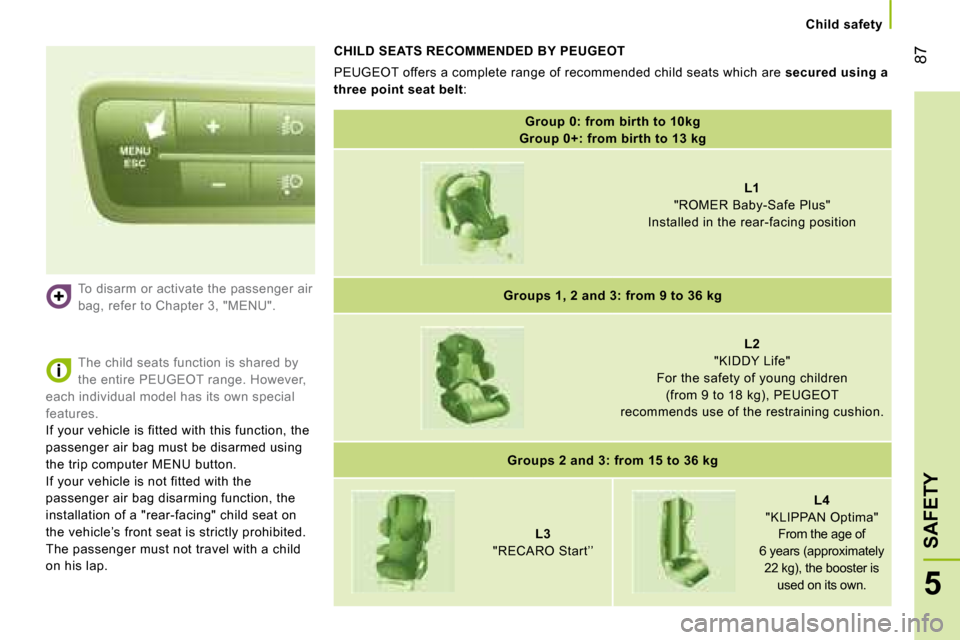
87
5
SAFETY
Child safety
To disarm or activate the passenger air
bag, refer to Chapter 3, "MENU".
CHILD SEATS RECOMMENDED BY PEUGEOT
PEUGEOT offers a complete range of recommended child seats which are secured using a
three point seat belt :
The child seats function is shared by
the entire PEUGEOT range. However,
each individual model has its own special
features.
If your vehicle is fitted with this function, the
passenger air bag must be disarmed using
the trip computer MENU button.
If your vehicle is not fitted with the
passenger air bag disarming function, the
installation of a "rear-facing" child seat on
the vehicle’s front seat is strictly prohibited.
The passenger must not travel with a child
on his lap.
Group 0: from birth to 10kg
Group 0+: from birth to 13 kg
L1
"ROMER Baby-Safe Plus"
Installed in the rear-facing position
Groups 1, 2 and 3: from 9 to 36 kg
L2
"KIDDY Life"
For the safety of young children (from 9 to 18 kg), PEUGEOT
recommends use of the restraining cushion.
Groups 2 and 3: from 15 to 36 kg
L3
"RECARO Start’’
L4
"KLIPPAN Optima" From the age of
6 years (approximately 22 kg), the booster is used on its own.
Page 96 of 131
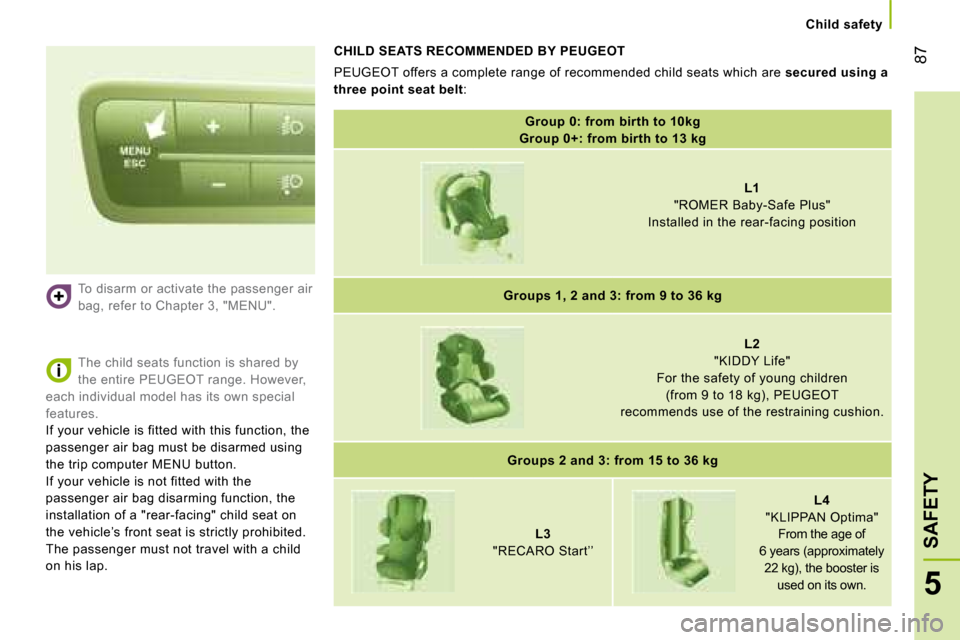
87
5
SAFETY
Child safety
To disarm or activate the passenger air
bag, refer to Chapter 3, "MENU".
CHILD SEATS RECOMMENDED BY PEUGEOT
PEUGEOT offers a complete range of recommended child seats which are secured using a
three point seat belt :
The child seats function is shared by
the entire PEUGEOT range. However,
each individual model has its own special
features.
If your vehicle is fitted with this function, the
passenger air bag must be disarmed using
the trip computer MENU button.
If your vehicle is not fitted with the
passenger air bag disarming function, the
installation of a "rear-facing" child seat on
the vehicle’s front seat is strictly prohibited.
The passenger must not travel with a child
on his lap.
Group 0: from birth to 10kg
Group 0+: from birth to 13 kg
L1
"ROMER Baby-Safe Plus"
Installed in the rear-facing position
Groups 1, 2 and 3: from 9 to 36 kg
L2
"KIDDY Life"
For the safety of young children (from 9 to 18 kg), PEUGEOT
recommends use of the restraining cushion.
Groups 2 and 3: from 15 to 36 kg
L3
"RECARO Start’’
L4
"KLIPPAN Optima" From the age of
6 years (approximately 22 kg), the booster is used on its own.
Page 97 of 131
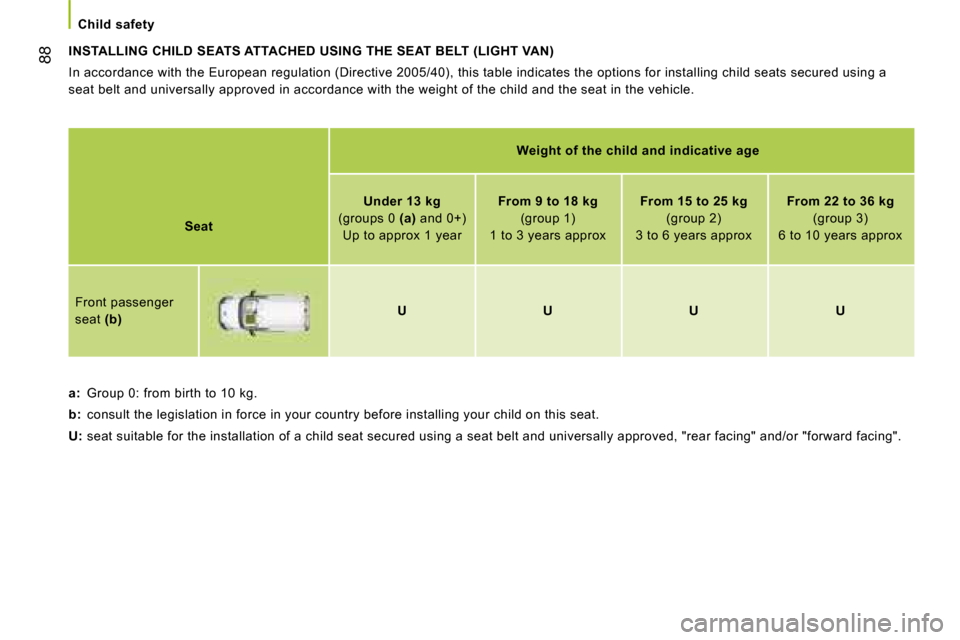
88
Child safety
INSTALLING CHILD SEATS ATTACHED USING THE SEAT BELT (LIGHT VAN)
In accordance with the European regulation (Directive 2005/40), this table indicates the options for installing child seats secured using a
seat belt and universally approved in accordance wi th the weight of the child and the seat in the vehicle.
Weight of the child and indicative age
Seat
Under 13 kg
(groups 0 ( a ) and 0+)
Up to approx 1 year
From 9 to 18 kg
(group 1)
1 to 3 years approx
From 15 to 25 kg
(group 2)
3 to 6 years approx
From 22 to 36 kg
(group 3)
6 to 10 years approx
Front passenger
seat ( b )
U U U U
a: Group 0: from birth to 10 kg.
b: consult the legislation in force in your country before installing your child on this seat.
U: seat suitable for the installation of a child sea t secured using a seat belt and universally approve d, "rear facing" and/or "forward facing".
Page 98 of 131
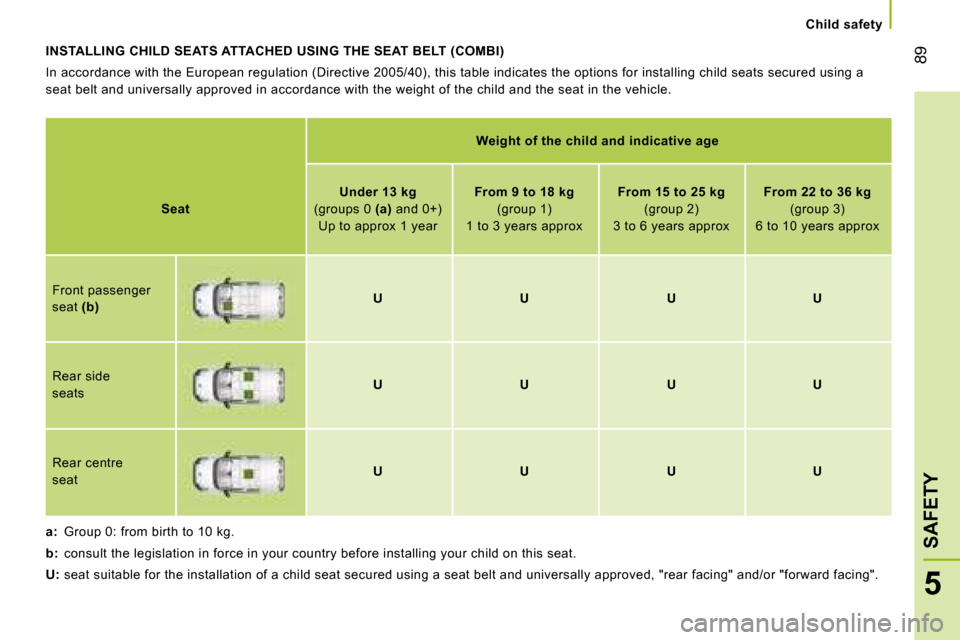
89
5
SAFETY
Child safety
INSTALLING CHILD SEATS ATTACHED USING THE SEAT BELT (COMBI)
In accordance with the European regulation (Directive 2005/40), this table indicates the options for installing child seats secured using a
seat belt and universally approved in accordance wi th the weight of the child and the seat in the vehicle.
a: Group 0: from birth to 10 kg.
b: consult the legislation in force in your country before installing your child on this seat.
U: seat suitable for the installation of a child sea t secured using a seat belt and universally approve d, "rear facing" and/or "forward facing".
Weight of the child and indicative age
Seat
Under 13 kg
(groups 0 ( a ) and 0+)
Up to approx 1 year
From 9 to 18 kg
(group 1)
1 to 3 years approx
From 15 to 25 kg
(group 2)
3 to 6 years approx
From 22 to 36 kg
(group 3)
6 to 10 years approx
Front passenger
seat (b)
U U U U
Rear side
seats
U U U U
Rear centre
seat
U U U U
Page 99 of 131
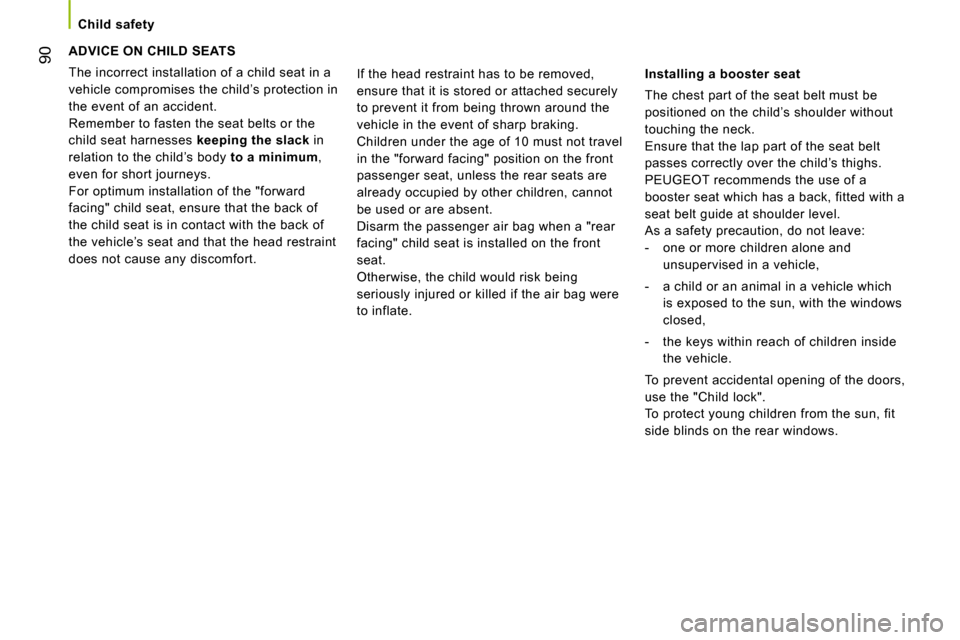
90
Child safety
ADVICE ON CHILD SEATS
The incorrect installation of a child seat in a
vehicle compromises the child’s protection in
the event of an accident.
Remember to fasten the seat belts or the
child seat harnesses keeping the slack in
relation to the child’s body to a minimum ,
even for short journeys.
For optimum installation of the "forward
facing" child seat, ensure that the back of
the child seat is in contact with the back of
the vehicle’s seat and that the head restraint
does not cause any discomfort. Installing a booster seat
The chest part of the seat belt must be
positioned on the child’s shoulder without
touching the neck.
Ensure that the lap part of the seat belt
passes correctly over the child’s thighs.
PEUGEOT recommends the use of a
booster seat which has a back, fitted with a
seat belt guide at shoulder level.
As a safety precaution, do not leave:
- one or more children alone and unsupervised in a vehicle,
- a child or an animal in a vehicle which is exposed to the sun, with the windows
closed,
- the keys within reach of children inside the vehicle.
To prevent accidental opening of the doors,
use the "Child lock".
To protect young children from the sun, fit
side blinds on the rear windows.
If the head restraint has to be removed,
ensure that it is stored or attached securely
to prevent it from being thrown around the
vehicle in the event of sharp braking.
Children under the age of 10 must not travel
in the "forward facing" position on the front
passenger seat, unless the rear seats are
already occupied by other children, cannot
be used or are absent.
Disarm the passenger air bag when a "rear
facing" child seat is installed on the front
seat.
Otherwise, the child would risk being
seriously injured or killed if the air bag were
to inflate.
Page 100 of 131
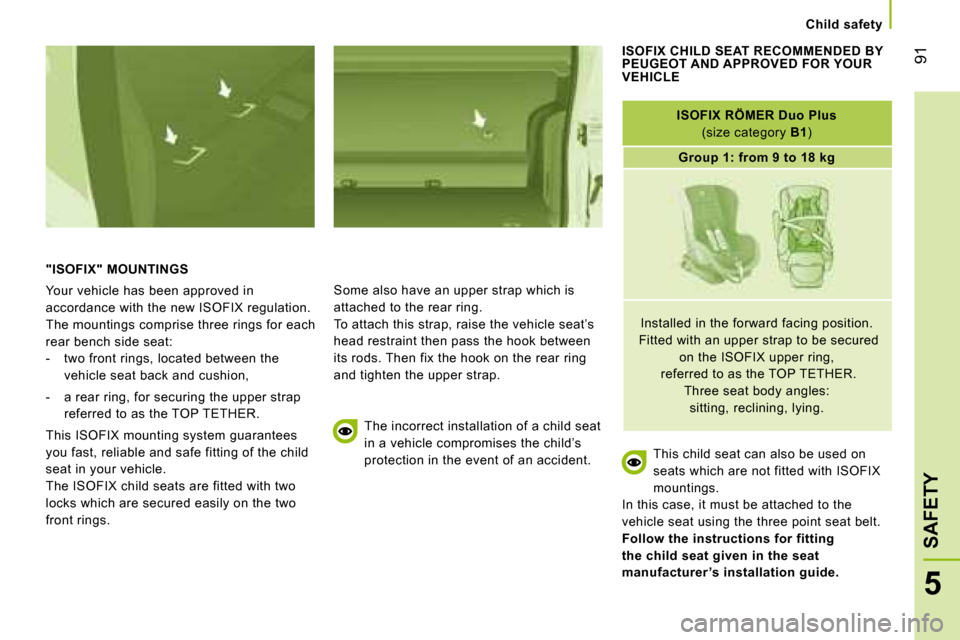
91
5
SAFETY
Child safety
"ISOFIX" MOUNTINGS
Your vehicle has been approved in
accordance with the new ISOFIX regulation.
The mountings comprise three rings for each
rear bench side seat:
- two front rings, located between the vehicle seat back and cushion,
- a rear ring, for securing the upper strap referred to as the TOP TETHER.
This ISOFIX mounting system guarantees
you fast, reliable and safe fitting of the child
seat in your vehicle.
The ISOFIX child seats are fitted with two
locks which are secured easily on the two
front rings. Some also have an upper strap which is
attached to the rear ring.
To attach this strap, raise the vehicle seat’s
head restraint then pass the hook between
its rods. Then fix the hook on the rear ring
and tighten the upper strap.
The incorrect installation of a child seat
in a vehicle compromises the child’s
protection in the event of an accident.
ISOFIX CHILD SEAT RECOMMENDED BY PEUGEOT AND APPROVED FOR YOUR VEHICLE
ISOFIX RÖMER Duo Plus
(size category B1 )
Group 1: from 9 to 18 kg
Installed in the forward facing position.
Fitted with an upper strap to be secured on the ISOFIX upper ring,
referred to as the TOP TETHER. Three seat body angles: sitting, reclining, lying.
This child seat can also be used on
seats which are not fitted with ISOFIX
mountings.
In this case, it must be attached to the
vehicle seat using the three point seat belt.
Follow the instructions for fitting
the child seat given in the seat
manufacturer ’s installation guide.